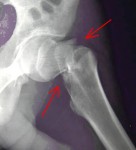 Painful Hip Fractures Strike Breast Cancer Survivors
Painful Hip Fractures Strike Breast Cancer Survivors
A hip fracture is not common in a 54-year-old woman, unless she is a 54-year-old breast cancer survivor, according to a new Northwestern Medicine study. Researchers found that a combination of early menopause due to breast cancer treatment and common drugs used to treat breast cancer, could be weakening the bones of breast cancer survivors once they hit middle age, leading to hip fractures.
Results of the study are published in the February 2011 issue of Clinical Cancer Research.
Hip fractures are rare in people under 70. Yet, Northwestern Medicine physician Beatrice Edwards, M.D., found that several breast cancer survivors in their early 50s were coming to her for treatment of hip fractures. Edwards is director of the Bone Health and Osteoporosis program and associate professor of medicine and of orthopaedic surgery at Northwestern University Feinberg School of Medicine.
Researchers studied six of these women over one year and assessed the type of breast cancer they had, the treatment they underwent and a hip fracture’s effect on quality of life, said Edwards, lead author of the study.
“One year after the fracture the women still reported difficulty with climbing stairs, shopping and heavy housekeeping,” Edwards said. “Their health care costs may increase and their fractures contribute to losing some independence.”
Edwards was surprised to find that the majority of the women did not have osteoporosis, but did have lower than normal bone mineral density (osteopenia). This suggests that rapid change in bone architecture from chemotherapy, early menopause and adjuvant therapy may not be evident on bone mineral density test, Edwards said.
The women had early-stage breast cancer and received treatment including lumpectomy, radiation therapy and chemotherapy with cytoxan and adriamycin one to four years before the fracture occurred. They were all perimenopausal at the time of the fracture.
Four of the six women had breast cancer that grew in response to estrogen and received aromatase inhibitors (AIs) as part of their cancer therapy to block their bodies from making estrogen. Recent studies have linked AIs with possible bone loss in women. Edwards’ team also reviewed reports from the FDA’s adverse event reporting system and other databases and found that AIs were the most common drug class associated with hip fractures.
“Although the majority of women with breast cancer can expect to be fully cured from the disease, the prevention of cancer treatment-induced bone loss is important to consider in cancer survival,” Edwards said. “More research needs to be done before treatment guidelines are changed, but greater awareness of the adverse effects of certain breast cancer drugs is needed.”
Edwards said the next step is for researchers to conduct a clinical trial and give bone density screenings to women before they enter breast cancer chemotherapy. High-risk patients would be flagged and given preventive bone loss therapy and monitored for premature hip fractures.
“The pain and suffering and hospital stays and higher health costs associated with these hip fractures might be prevented through early intervention,” Edwards said.
The title of the paper is “Cancer therapy associated bone loss: Implications for hip fractures in mid-life women with breast cancer.”
By Erin White, Northwestern Newscenter

Comments